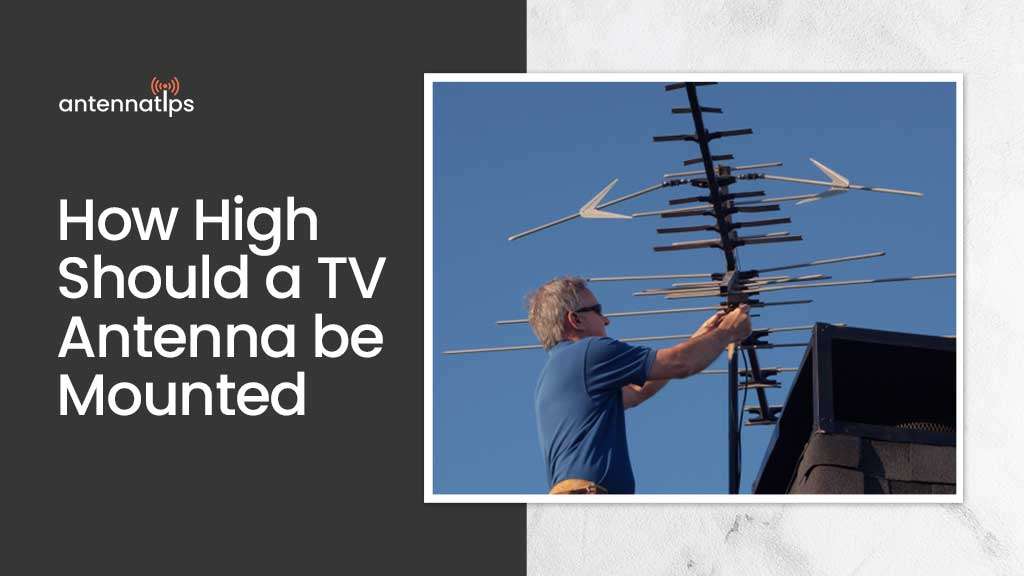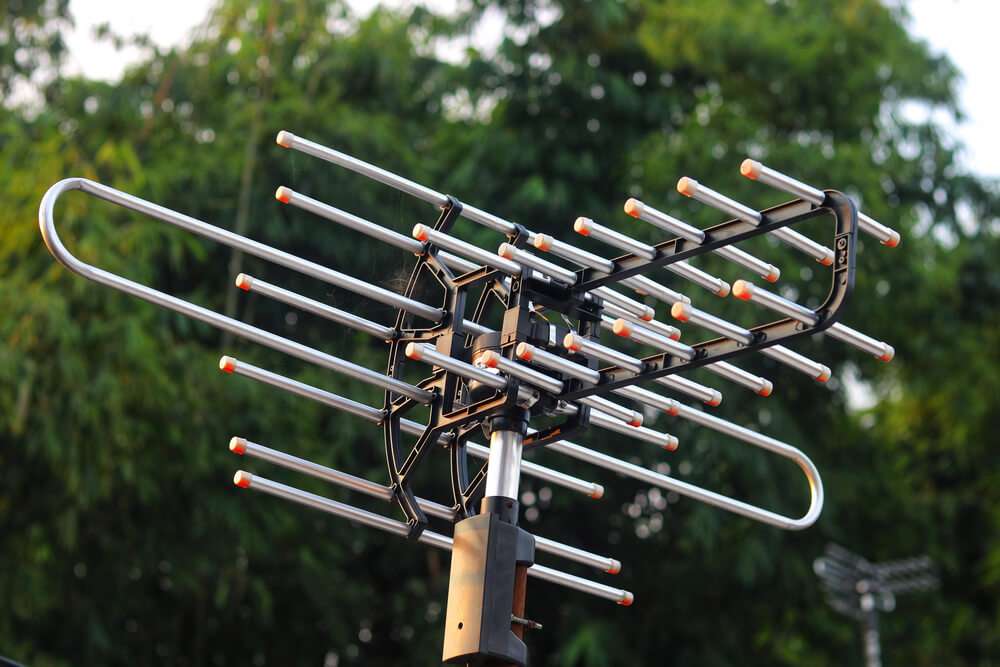
Well, higher is always better. You get less to almost no obstructions. How high should a TV antenna be mounted? Ideally, to get the best reception possible, it’s recommended to have your antenna at least 30 feet from the ground. The higher you have it up, the more clear the pathway would be.
But it would also depend on where you’re going to install it. So in this article, we are going to teach you how to get the ideal TV antenna height.
And don’t get too fixated on the height of the TV antenna, several factors will determine a clear signal reception. And we’re going to enumerate them. stay tuned!
Factors That Affect TV Signal Reception
Pixelated images and unclear sounds? Your TV reception could use a refresher. Here are several factors that can also affect your TV signal reception.
1. Distance from the broadcast tower
The further you are from the broadcast tower, the weaker the signal will be. And your proximity to the tower will also dictate how many channels your antenna can pull in. Ideally, you should be located within a 65-mile radius. Outside that, it’s going to be bleak. If that’s the case, you’d need a long-range antenna.
2.Obstructions
Obstructions can come in the forms of trees, buildings, valleys, hills, and mountains. Lots, right?
And here is where your line of sight would come into play. The broadcast tower should be in your line of sight. If you can’t see it due to the numerous obstructions, you’re likely to get a bad TV signal reception.
And this is where you have to get the best possible height for your antenna installation. If you have your antenna high up, you’ll be able to get past the obstructions. And this will enable your antenna to be in the line of sight with the broadcast tower. So this is where the saying the higher the better applies.
But how high? Let’s see.
Tips On Getting your Antenna Up High
As the introduction mentions, the higher your antenna is, the better. Normally 30 feet from the ground is high enough. Suppose you can get it to 40 feet from the ground; much better. If you want an exact computation, you can use this formula for the TV antenna height calculator.
But the problem is, it’s not always easy to get it as high as you want and need it to be. Several limitations will prevent you from mounting your antenna that high.
But worry not; there are also solutions on how you can overcome those limitations. And here are a few suggestions.
1. Old style TV antenna towers
Old-style TV antenna towers are solid and stable. It can make good solid support for a lot of quirky projects. So you can also use it to mount your antenna higher. You’re reusing an old tool too which is quite cool right?
2. Antenna tower kits
If you don’t have an old antenna tower, you can simply purchase antenna tower kits online.
3. Pergolas or shed
You can easily install your antenna on top of a pergola or shed. This will give your antenna more height.
4. Rooftop mounting
This is perhaps the most common solution homeowners resort to. Mounting your antenna up on the roof can help eliminate obstructions. But this one can be quite challenging.
So head on over to the next section to see how to properly install an antenna on your rooftop.

Outdoor Antenna Installation
So now that you’ve decided to mount your antenna up high on your rooftop, see our simple guide below. Remember, mounting on your rooftop requires extreme caution.
1. The number one rule is to carefully read the antenna instructions for mounting. Though generally, it’s the same, some brands may have additional requirements.
2. Then know the specifications of your TV. Your TVs should have a digital tuner. This will receive the signal and convert it into sound and pictures.
3. If your TV does not have a digital tuner, you can buy converter boxes. TV sets that are manufactured before 2009 often do not have a digital tuner.
4. You’ll be needing a ladder to access your roof. Make sure to use a sturdy, industrial-grade, and non-conductive ladder.
5. It also helps if you have a tool belt where you can safely keep the tools you need for installation. This is especially helpful if you’re going to stay on the ladder while mounting the antenna on your roof.
6. Secure all the tools and materials that you’re going to need for the installation. These are the general requirements, but your brand of antenna might require more.
- Base mount
- Antenna mast
- Wall bracket
- U-bolts
- Sealant
- Coaxial cable compression fittings
- Screwdriver
- Extra coaxial cable
- Compass
- Roofing screws
- Adjustable wrench
- Power drill
7. Locate where the broadcast tower is situated. Remember, to pull in the most TV stations, you have to be in the line of sight with the transmission tower.
8. Make sure that the antenna that you purchased has the sufficient reception range that you need.
9. If you’re mounting your antenna on a metal roof, mount it on a mast at least one meter. This will help overcome interference.
10. If you don’t know exactly where the transmission towers are located, go check where your neighbors’ antennas are pointing too.
11. You can attach a base mount on your rooftop. Make sure that it’s perfectly vertical.
12. Have a list of the broadcast towers of several TV stations. Then grab your compass and direct the TV antenna to the direction where the channels are located. Or you can alternatively point the antenna in the middle of the group of channels.
13.Run a coaxial cable between your antenna and TV. Aim to go straight and avoid sharp turns.
14. Make sure to attach the cables snugly to the mast. You can use electrical tapes of plastic tire wires.
15. When mounting antennas to the roof, you often need to drill holes in the ceiling. So that’s where you’ll use the power drill.
You may also like: Which End Is the Front of a TV Antenna?
Safety Tips
Identifying potential hazards can mean life and death. The roof is a challenging place to mount an antenna. And it requires extreme caution and preparedness. And if you have any doubts about doing a DIY, never attempt one. You have to be fully committed and mindful.
- Extra caution is needed for the following reasons:
- Most roofs have unstable footing.
- You can be close to power lines.
- Cables can be tripping hazards.
- It’s easy to lose your balance if you’re high up on the roof.
2. Don’t ever attempt to step on a metal roof if it’s wet.
3. Always wear slip-resistant shoes when accessing the roof.
4. Never skimp on the ladder. Always use industrial non-conductive ladders.
5. Make sure to properly position your ladder.
6. Check for the condition of the roof first. Are there any shingles or weak spots?
7. Be mindful of where the power lines are located. And if your antenna gets tangled up in these power lines, never attempt to remove it yourself.
8. Check if there are wasps or overhanging branches.
Additional Tips on Getting a Clear Tv Signal
Aside from mounting your antenna as high as possible, here are other tips for getting clear pictures and crisp sound on your TV.
- Keep the coaxial cables as short as possible.
- Run a straight course with the cable. Avoid sharp turns and routes.
- The fewer splitters, the better. But if you need to connect your antenna to more TVs, you can use a network tuner instead.
- Buy a high-quality antenna.
Conclusion
How high should a TV antenna be mounted? Our guide will help you determine how high up it should be. And we also tossed in several tips on how to mount it safely on your roofs.